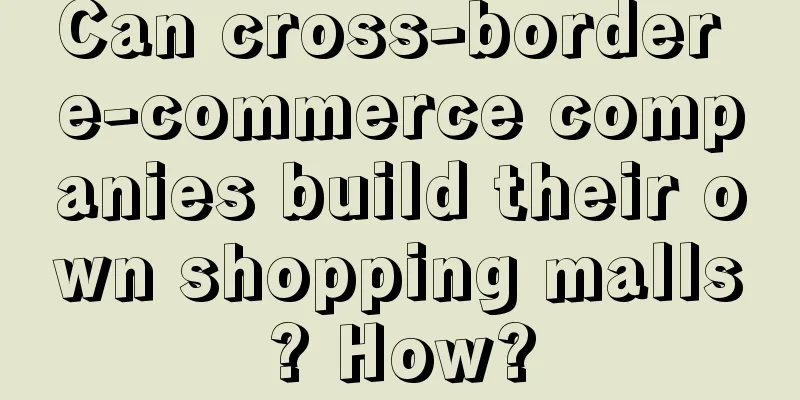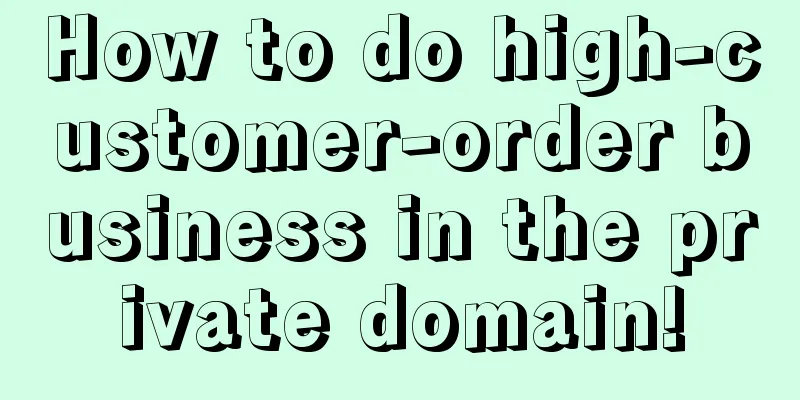Can cross-border e-commerce companies build their own shopping malls? How?

|
With the progress of global economic integration, cross-border e-commerce has become a huge business opportunity. However, it is not easy to carry out cross-border e-commerce operations in different countries and regions and achieve success. This article will explore how to carry out localized operations of cross-border e-commerce from multiple aspects. 1. Can cross-border e-commerce companies build their own shopping malls? When conducting cross-border e-commerce business, many people will face an important question: Can they build their own cross-border e-commerce mall? The answer is yes. Cross-border e-commerce can build and operate their own mall. With the development of technology and the popularity of e-commerce platforms, building a mall of your own has become relatively simple and easy. The advantage of building your own mall is that you can more flexibly control product types, prices, sales strategies, etc., while also being able to establish your own brand image. 2. How to do it? Determine the type of mall. First, if you want to run a cross-border e-commerce mall, you need to determine the type of mall. Common mall types on the market include B2C (business to consumer), C2C (consumer to consumer) and B2B (business to business). Choose a mall type that suits you based on your products and target customer groups. Register a company and obtain relevant licenses Before engaging in cross-border e-commerce operations, you need to register a company and obtain relevant licenses. These certificates may include business registration certificates, tax registration certificates, customs registration, etc. Depending on the regulatory requirements of different countries and regions, you may also need to go through some additional procedures and approvals. After determining the type of store and obtaining relevant licenses, the next step is to choose a suitable e-commerce platform to build your own store. There are many well-known e-commerce platforms to choose from in the market, such as Shopify, WooCommerce, Magento, etc. You can choose the most suitable platform according to your needs and budget. Once you have chosen the right e-commerce platform, the next step is to build your own shopping mall website and design an attractive user interface. This requires some technical and design knowledge. If you do not have this ability, you can consider hiring a professional web developer or designer to help you complete it. Finding suppliers and products A successful cross-border e-commerce mall is inseparable from high-quality suppliers and unique products. You can find suitable suppliers and products by participating in international trade fairs, establishing connections with overseas merchants, or using some B2B platforms. At the same time, you should also pay attention to ensure that the products you sell comply with the laws, regulations and quality standards of the target market. Establish a logistics and payment system. Cross-border e-commerce involves international transportation and payment, so you need to establish a reliable logistics and payment system. You can choose to cooperate with an international logistics company to ensure that the products can reach consumers safely and quickly. At the same time, you should also choose a safe and reliable payment method to smoothly collect payments from consumers. Finally, if you want your store to stand out in the fiercely competitive cross-border e-commerce market, you need to do a good job in marketing and brand building. This includes online advertising, participating in exhibitions, and cooperating with social media influencers. Through effective marketing and brand building, your store will be able to attract more target customers and increase sales. With the continuous advancement of technology and the opening of the global market, cross-border e-commerce can become a reality. By choosing the right type of mall, registering a company and obtaining relevant certificates, choosing a suitable e-commerce platform, building a website and designing a user interface, finding high-quality suppliers and products, establishing a reliable logistics and payment system, and doing a good job of marketing and brand building, you can successfully build a cross-border e-commerce mall yourself. Recommended reading: Which platform should I choose for my personal cross-border e-commerce business? What are the requirements for entry? How much does it cost for personal cross-border e-commerce? Do I need a deposit? Can cross-border e-commerce personal trademarks be registered? What are the regulations? |
>>: How much is the sales revenue of a cross-border e-commerce company? How to make good sales?
Recommend
As AI creations become increasingly popular and digital humans and virtual anchors emerge, how can guilds and organizations keep up with the trend?
The development of the AI industry has penetrate...
What does IP leak mean? How to prevent it?
IP leakage occurs when the IP address (Internet Pr...
What are the Amazon compliance submission tips? How to use Amazon compliance features?
Merchants who have opened stores on the Amazon pla...
Does Amazon Advertising need to run 24 hours? What should I pay attention to when running Amazon Advertising?
After opening a store on Amazon, everyone will try...
Is Amazon suitable for novice sellers? Which category should I choose?
With the rise of e-commerce, more and more people ...
In the annual Spring Festival Marketing Competition, how do the rabbit and I come up with thousands of tricks?
For brand marketing, the Lunar New Year as a marke...
Why are people less and less interested in scanning codes?
Starting from the current situation that "peo...
It’s not Pinduoduo that defeats Alibaba!
Pinduoduo's market value surpassed Alibaba? Wh...
618, how are the new consumer brands doing?
At the beginning of 2023, all topics surrounding c...
Who is bearing the cost of e-commerce price wars?
In 2024, the low-price war among e-commerce platfo...
From Southeast Asia to Japan and South Korea, Mixue Ice City's overseas expansion
Recently, many netizens posted photos of the grand...
How does Amazon know whether an order is a natural order? How to distinguish?
There are many merchants opening stores on Amazon ...
How to set up an avatar on Shopee? What should I pay attention to?
After registering a Shopee store, you need to make...
Businessmen who make a living on WeChat are turning to short videos
Nowadays, the income of micro-businesses is not as...
Amazon announces the latest delivery time for Black Friday and Christmas
Amazon's US and European sites have announced ...









